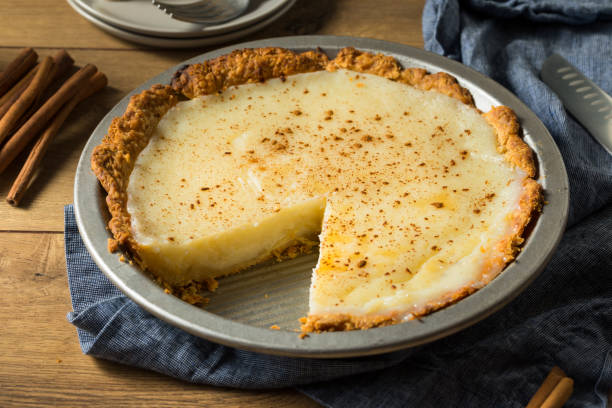One of the best-known desserts in the world, this custard pie features a perfectly soft egg custard filling prepared with just milk, eggs, & cream.
Egg Custard Pie
No one should know, but I think Classic Custard Pie is the best of all the pies on my website. This pie is so simple to make, and it uses items that almost everyone already has in their kitchen. I couldn’t get enough of it, especially if it is done well! So, as a result, I devised this dish.
No sloppy bottoms, preferably, and a smooth, creamy egg-based fill that is not being overbaked will be the characteristics of an excellent custard pie. Do not forget to sprinkle some freshly grated nutmeg on the pie’s topping in flavor and texture.
So, why do we not get started on it? While the writing that follows is chock-full of advice and suggestions, you may skip down to the recipe and get started right away if you choose.
Below is a list of all the components needed to make a custard pie. The complete recipe is provided in further detail below.
- Best quality vanilla extract
- eggs
- milk
- cream
- sugar
- flour
- Grated nutmeg
- salt
- butter
Required tools
The main ingredients, equipment, and ingredients I utilized to create this dish are listed below. You do not have to utilize all of these, but these are what I did.
- food processor (for chopping vegetables) (to prepare the pie dough)
- Essentials for the kitchen, including a baking scale, bowls, measuring cups, and weighing spoons
- Dry rice and beans, as well as pie weights (for blind baking)
- a pie plate
- a filter (a fine mesh)
- rolling pin
Making the Crust for the Pie
This custard pie’s flaky sweet pie crust perfectly with the rich, creamy custard. Everything can be done in a food processor, and it is ready to use right away! You ought to be able to roll it out like playdough if you are patient and careful.
It does, however, necessitate a blind bake. The custard in this recipe is baked at 325 degrees Fahrenheit. Because the crust cannot be baked at that temperature, you must completely blind bake the dough before assembling the pie.
Please remember that the pie crust would not need to be pierced. This custard pie filling is overly runny, and if the crust has holes in it, the filling is bound to spill through. Also, make that your pie dough is smoothed out evenly and free of cracks.
How to Make a Custard Pie in the Classic Style
My apologies, but preparing a custard pie requires more than merely combining the ingredients and baking. But that does not imply it is difficult; it only requires a few basic guidelines to be followed.
A summary of the stages for the dish is provided below, followed by a few helpful hints to ensure your success.
Step-by-Step Process:
- prepare the pie crust by rolling it out and baking it blind.
- Combine all of the ingredients in a mixing bowl and whisk until smooth.
- Put the pie filling into the cooked pie crust and bake it.
- Allow the pie to cool completely before cutting into it.
Scalding the milk is not included in those instructions; therefore, I will leave it out. Many classic custard pie recipes instruct the cook to “scald” the milk before adding it to the eggs. Initially, when I began baking custard pie, I followed this custom. Eventually, I questioned whether or not it was essential. I tried this recipe to investigate if missing this step affected the creamy filling. It turns out that scalding the milk is not essential after all. Despite this, the filling must be strained twice, as per the directions. Some of the air bubbles will be eliminated due to this process; it also removes any clotted egg yolks.
The instructions to make custard pie
Bake the pie crust thoroughly: The pie crust must be fully baked before adding the filling. You run the danger of fracturing the crust if you put the custard through an unbaked crust; thus, it is best to bake the crust before pouring in the custard. In addition, custards are cooked at a low temperature, making it difficult for the crust to bake while the contents are still in the custard dish.
It was my experience that over-whisking the eggs resulted in an excessive amount of aeration and air bubbles. After that, the bubbles started to form throughout the baking process and burst. But even if this does not affect flavor, it is a little distasteful to look at. To avoid this, mix the filling ingredients with a light hand.
The eggs and sugar should not be left together for too long: Sugar can thicken egg yolks. If this does occur, straining it twice will help remove any remaining residue.
After cooling, slice thinly. As they cool, the custard pies finish hardening and firming up. Let the refrigerator do the heavy lifting while you relax and unwind. You will get custard soup if you try to chop it before it is entirely cold.
How to prevent your custard from spilling?
It might seem like a simple matter, but if you’ve ever attempted to lift an unbaked pie with just a fluid filling into the oven while spilling it, you know it isn’t simple! I prefer not to bake the crust first and then stuff it, as some other bakers do. This method is more likely to spill or burn if I use the oven’s heat.
Instead, I’ll provide you with advice for a flawless transferring of an unbaked custard pie further into the oven:
- Never keep your eyes off the interior.
- Open the oven and check the position of the shelf before trying to move the pie (which would be the middle).
- Start picking up your pie and pay attention to the liquid center during the entire process. When you turn your back off the unsteady filling, you fear leaking.
Custard Pie: The Right Way to Make It!
Over-baking custard pies are one of the most important pie tips I can give anyone. In addition to custard pies, I am talking to any dessert with dairy and eggs combined.
It should be just set when a custard-style pie is cooked to perfection. It is basically “boiling” the eggs if you overcook their eggs. A typical custard pie, for example, might have a flavor of overcooked eggs as a result. As a result, the pie may be hard or soft. This is more likely to result in pies that are broken or divided. Custard is safe for consumption when it reaches a temperature of 170o to 200o. The temperature at which custard sets varies slightly from recipe to recipe. The ideal temperature for this pie is between 170oF and 180oF.
Looking at the outside edges of a pie to check whether they seem to have a set is another way to tell if it is done baking. The pie’s outside borders should be firm, but the center should jiggle slightly. Also, make sure that the center does not appear to be too liquidy. That would indicate that it is undercooked.
Once the pie has cooled, it will be ready to serve. For best results, chill it in the fridge for at least four hours before serving.
Troubleshooting and answers to commonly asked issues about Custard Pie are provided here.
Why is there yellow in the unbaked filling?
A few cubes of hard-boiled egg. If you think you may have accidentally boiled the egg, be careful to strain it.
Although the pie filling appears unstable, I am concerned that it has not been fully cooked.
This is exactly what I was looking for! Even though the core of the pie is still a little shaky, it is done baking. A minimum of two inches should be placed between the borders, but the middle should still sag slightly. This is because a thicker liquid with movement, like jello, is used for the wobbling filler instead of liquid. After it comes out of the oven, it will continue to harden.
A crack or bubble appeared in the pie filling!
Possibly the filling has leaked out of the pie shell because you overheated the pie, over whipped the filling, or whisked the filling too much. The pie will still taste good if the filling is not overdone. If you put a layer of whipped cream on top of the pie, nobody will notice the difference!
Top your pie with whipped cream and more freshly grated nutmeg before serving. One day ahead of time is fine for this pie. Then, store it in the freezer.

